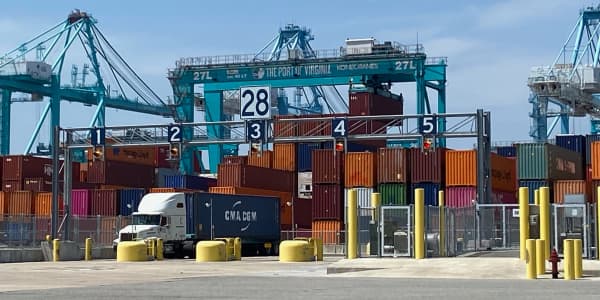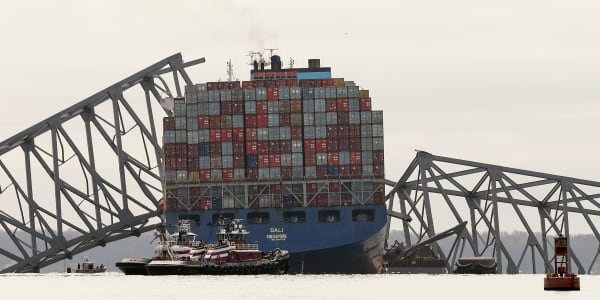
Inflation is down significantly, the stock market is more ebullient than it has been in a year, and the latest monthly national retail sales report came in stronger than expected, but retailers don't expect that to change what is shaping up to be a downbeat holiday spending season in 2023, according to the latest CNBC Supply Chain Survey.
The survey's early read on peak season order activity shows retailers ordering less and expecting the consumer to be on the lookout for discounts and freebies to entice them to buy more.
Last summer, big-box retailers Target and Walmart surprised the market when they revealed huge inventory builds that led to a period of steep markdowns. Many retailers are still drawing down inventories now as peak season for orders begins.
The big-box leaders indicated during recent Q1 earnings reports that consumers are spending less, and other new CNBC retail surveying indicates that the consumer situation continues to deteriorate. The unseasonable items clogging warehouse shelves have been a problem of varying degrees for all respondents.
"Cleary, inventory and inflation concerns remain top of mind for apparel and footwear executives as we enter peak shipping season," said Stephen Lamar, president and CEO of the American Apparel & Footwear Association.
The largest grouping of respondents (43%) expect a lower peak season compared with last year, and 21% of those surveyed expect the level of orders to be the same.
The American Footwear and Apparel Association, National Retail Federation, Council of Supply Chain Management Professionals, and United National Consumer Suppliers were among respondents to the CNBC survey, which was conducted May 24-June 11 among 147 respondents. The survey took place during a period that coincided with West Coast port labor slowdowns that increased fears about potential inflationary impacts of supply chain congestion, before a tentative deal was reached between port management and the labor union Wednesday.
Even with inflation down from over 9% last summer to 4% in the most recent CPI reading for May, 71% of those taking the survey said they are concerned the consumer will cut back on holiday spending in response to inflation.
Roughly two-thirds (67%) of those surveyed expect consumers to look for discounts.
Based on the concerns about cutbacks by consumers, 77% of all items being ordered this holiday season are middle price-point items, including jackets.
The majority of items in warehouses are sweaters, followed by boots, dresses, and evening purses.
More than half (52%) of orders will be promotional products, such as free gifts with purchase.
Only 17% of items ordered are high-end items in apparel, electronics and memorabilia.
CEOs in the retail sector have recently indicated that even though the high-end consumer has remained strong in a softer economy, there are signs that the luxury market has peaked.
The concerns about the consumer, which has proven resilient during more than a year of shifting timelines on when a recession will hit the U.S., come as the latest CNBC Fed Survey released earlier this week shows economists, Wall Street strategists and money managers now expecting a recession to finally begin in the fourth quarter of the year. In the Fed Survey, 54% predict a recession in the next 12 months, and the average start month is now at the onset of holiday shopping season: November.
Brett Rose, CEO of United National Consumer Suppliers, a supplier to Amazon third-party sellers as well as TJ Maxx, Macy's, HomeGoods, and Ross Stores, said if retailers already concerned about inventory levels are worried about consumers cutting back, they should use that as an opportunity to move more goods. Even if it means sacrificing margin and profitability on some inventory, it is the way to give consumers what they are looking for: discounts, he said.
"[The] 67% of those surveyed claiming consumers will be looking for discounts [this] holiday season, they need to capitalize on the bloated inventory," Rose said. "Use the bloated inventory to hook the consumer, and while shopping there will be additional purchases," he said.
Jon Gold, vice president of supply chain and customs policy at the National Retail Federation, said the survey results highlight the ongoing stress and challenges that retailers and other businesses are facing in their supply chains.
"Retailers are constantly working to ensure they have the right inventory mix to meet consumer demands, especially as we enter the peak shipping season for the holidays," Gold said. "The ongoing challenges with the West Coast port labor negotiations and associated disruptions have certainly impacted some supply chain decisions. Many shippers have shifted cargo away from the West Coast and may decide to permanently shift away, even after the tentative deal is finalized."
The labor union has said it will take months to ratify the deal among its rank and file members.
Previous CNBC Supply Chain Survey data has shown supply chain managers to be wary of moving shipping back to the West Coast after a year of labor volatility. When asked in the latest survey if they were returning more freight to the West Coast, just about half (51%) indicated they were not.
Traditionally, retail sector orders for peak season items are placed in late winter or early spring. This year, with many retailers still drawing down inventories, the timing of placing holiday orders has been more varied. Seventeen percent of respondents said they placed their orders for holiday items three months ago; 12% said they placed their orders two months ago, 14% said they ordered six months ago; another 14% said they ordered more than six months ago.
Labor costs and bloated inventories continue to be a drag on participants followed by warehouse costs and labor shortages.
Trucking, ground, rail profit hits
For ground logistical firms, rail companies and short-haul trucking, the peak holiday shipping season is a lucrative and critical time of year for making money.
Given the anticipated consumer pullback, freight order volume is not expected to exceed 2022 levels for the majority of logistics firms, with 43% of respondents saying they would be moving less. One quarter (26%) expect freight volume to be at a level similar to that of 2022; 21% forecast higher freight activity. The largest subgroup of survey respondents who predict placing higher freight orders (42%) pegged the increase in a range of 6%-10%. Respondents that said freight volume will be down provided a range from 6% to more than 15%.
Mark Baxa, CEO of the Council of Supply Chain Management Professionals, said the results reflect the overarching theme of a conservative approach with inventory this peak season.
"More so, supply chains are essentially taking a wait-and-see approach to shifting back to the West Coast as a whole," said Baxa. "Inventory carryover and concerns over sentiment that consumers are seeking price discounts due to inflation are key factors."
Given the uncertainty among consumers and in the supply chain, CNBC asked respondents if they are considering deploying more artificial intelligence for deeper inventory analysis. The majority (57%) said they are not, while 31% said they are.





